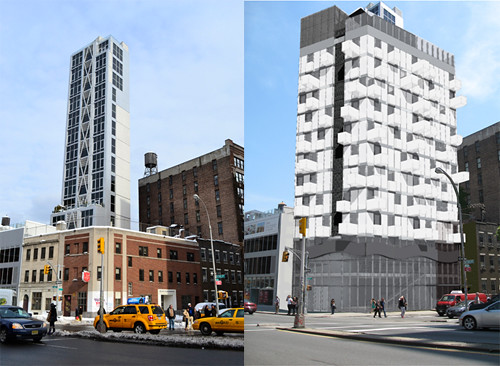 Courtesy of Gene Kaufman Architect The Salvation Army building at the corner of Bowery and East Third Street. Right: A rendering of what the corner will look like when Gene Kaufman’s Bowery boutique hotel is completed.
Courtesy of Gene Kaufman Architect The Salvation Army building at the corner of Bowery and East Third Street. Right: A rendering of what the corner will look like when Gene Kaufman’s Bowery boutique hotel is completed.Much has been said about the design for the new boutique hotel and restaurant that is expected to take the place of the vacant Salvation Army building on the corner of the Bowery and East Third Street.
Several local blogosphere commentators have made it clear that this addition is not welcome in their neighborhood. Andrew Berman, executive director of the Greenwich Village Society for Historic Preservation, jokingly referred to the 11-story, 72-room hotel as the “red tumor building” in reference to a series of asymmetric balconies that will protrude from the building and glow red at night.
“It’s totally inappropriate and I think it will be another unfortunate, unwanted intrusion into the Bowery,” said Mr. Berman. “The scale is wrong, the design is wrong. It almost seems designed to offend.”
Gene Kaufman, the architect hired by the Paris-based Louzon Group to design the hotel and restaurant, is aware of the East Village’s reaction to the renderings published by The New York Observer last month, but is hoping it might not be permanent.
“The neighborhood sentiment in the beginning is the start of a process,” said Mr. Kaufman, who has designed other controversial hotels in New York. “It’s not necessarily reflective of what’s going to happen in the long term.”
Mr. Kaufman believes the architectural past and future of the East Village exist as separate but not necessarily opposed pieces of the neighborhood’s identity. His goal is to create a structure that is forward-looking rather than an allusion to the 19th-century architecture of the Bowery, which he said “seems extremely remote.”
His building’s facades will be white and reflect the conditions of the sky, said Mr. Kaufman, who hopes these reflections and the shadows created by the unusual series of balconies will cause the structure to “dematerialize” against its backdrop.
Mr. Berman, for one, is not impressed. He said Mr. Kaufman’s hotels “tend to stick out like sore thumbs” and don’t improve with age.
“Nobody expects him to recreate a 19th-century building,” he said. “But his vision of the future of the Bowery and the East Village is not one that’s shared by anyone in the neighborhood that I know.”
As Mr. Berman sees it, Mr. Kaufman is failing to show consideration for the existing neighborhood that surrounds the site where the hotel is set to be built and where most buildings are smaller and less flashy.
“If you’re really trying to be respectful of the community in which you’re locating,” said Mr. Berman, “an effort to make the design fit in with and complement its surroundings as opposed to simply screaming, ‘I’m here, I’m new, I’m different!’ would probably be a better way to go.”
Mr. Kaufman understands that East Villagers are worried the Bowery will lose its character, but he said that the hotel and restaurant will be run responsibly and will be viewed as positive additions to the area.
As for the design, Mr. Kaufman quickly pointed out, “there’s nothing definite in architecture, design, construction, or real estate. That’s our initial concept. I think it will evolve. We have a whole design process still coming up.”
That process will have to be quick, however, because Mr. Kaufman and the Louzon group have said they plan to break ground in the fall and finish construction 18 to 21 months later.
Perhaps there is reason to believe people in the neighborhood will accept Mr. Kaufman’s hotel as originally conceived. Recently Sean Gibson, a 37-year-old East Village resident, looked at a drawing of the new hotel while standing at Bowery and East Third Street. He shrugged then compared Mr. Kaufman’s design with that of the Cooper Square Hotel, a 21-story, Carlos Zapata-designed tower in 2008.
“If you look against the backdrop of the other architecture in the area,” he said, “it looks kind of like it would fit in.”
Mr. Kaufman, no doubt, would see that reasoning as logical. But Mr. Berman and others would probably view the idea that one unusually tall building justifies the next as creating exactly the type of slippery slope they would like to avoid.
Join the conversation: What do you think East Village – eyesore or exciting new design?




